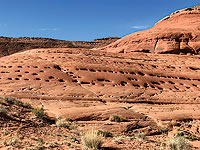 |
| Tafoni in the Slick Rock Member of the Entrada Formation. Parallel lines of uniform round tafoni are characteristic in cliffs and domes of the Slick Rock Member. |
Some of the cliffs and other bare rock surfaces near Moab contain lines of circular holes that indeed look like a giant species of woodpecker with a diamond-tipped bill was hunting for mineralogic meals within sandstone. Other cliff faces are pocketed with fantastically-shaped cavities and holes that resemble swiss cheese or perhaps a geologic sponge. Others rocks and boulders may covered with latticework of small pockets that almost appears as a lithified honeycomb.
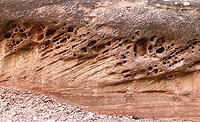 |
| Tafoni in a cliff face made of the Navajo Sandstone. These tafoni are preferentially oriented along the cross-bedding that formed during deposition in a sand dune environment. |
These holes in rocks are known as tafoni, with the word either coming from the Greek for tomb or from Romance language (Corsican or Sicilian) words for windows. Climbers sometimes call holds in these pockets huecos from the Spanish word for hole or hollows with the term being adapted from Hueco Tanks State Park in west Texas where these depressions are common in the granitic bedrock there.
On the Colorado Plateau, tafoni are most common in sandstone where there are stable rock surfaces, either that are part of cliff faces or sometimes on loose boulders. Sandstone is very simply a type of sedimentary rock that is made up sand grains (usually of the mineral quartz) that have been cemented together (by calcium carbonate, iron oxide, or silica although silica cements are rare in this region).
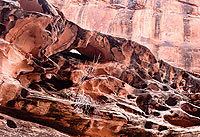 |
| Small arch formed by cavernous weathering in the Kayenta Formation in Hunter Canyon. |
Tafoni form during weathering. Weathering consists of the in situ (in place) physical disintegration and chemical decomposition of rocks at or near the Earth’s surface. The presence of water, exposure to gases in the atmosphere, the pull of gravity, mechanical processes such as freeze-thaw cycles, and even root action by plants, all play a role in weathering rock. (As a contrast, erosion is the transport of weathered rock material.)
The specific weathering processes that yield tafoni are alternatively called cavernous, alveolar, or honeycomb weathering, or sometimes salt weathering. The descriptive terms of cavernous, alveolar, and honeycomb all relate to the cavities produced by this type of weathering (alveoli are the tiny air sacs in the lungs where oxygen and carbon dioxide are exchanged).
Salt weathering refers to physical disintegration of rocks caused by the repeated dissolution, precipitation, and expansion of various salts (calcium, sodium, potassium, and magnesium-based compounds including calcium carbonate, gypsum and other minerals) on the surface due to wetting and drying cycles. These salts may come from within the rock layers or from external sources. Salt weathering is an important process in arid and semi-arid environments such as in southeastern Utah.
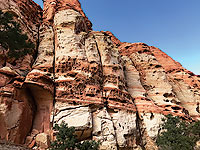 |
| Tafoni in the Wingate Sandstone in Cohab Canyon in Capitol Reef National Park. |
Once depressions begin to form on rock surfaces, they generally tend to deepen through a related process called differential weathering (weathering that occurs at different rates) and positive feedback loops. Growing surface pockets create microclimates that that preferentially cause them to enlarge. Cavities also protect surface salts from washing away during rain storms.
Tafoni may be of any size or shape, but they are typically spherical since much of the weathering occurs by grain-by-grain disintegration of the rock. Sometimes the inner surfaces of the cavities are friable meaning that they are easily crumbled and loose sand grains may come off if someone rubs them with their hand since the weathering processes have weakened or even removed much of the cement holding the grains together.
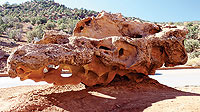 |
| A boulder deeply pocketed by tafoni. This Shinarump Member (Chinle Formation) boulder is resting on the Moenkopi Formation which contains a fairly high concentration of salts. Sandstone boulders lying on top of the Moenkopi are particularly susceptible to cavernous weathering. Tafoni aren’t typically found in the Moenkopi itself because it consists of thinly-bedded layers that are not conducive to the formation of cavities. |
The size and shape of pockets may be uniform in any given area where tafoni are present, but some areas have tafoni of widely divergent sizes. Sometimes small tafoni may be nested within larger cavities. Other times these rock pockets remain small and closely resemble honeycomb. Large tafoni may intersect and even lead to light openings in rocks that are large enough to be classified as natural arches. Bedding (layering) in the rock may exert some control over the location and placement of cavities, but not always.
Tafoni may be found in any of the massive sandstone layers (formations to geologists) found near Moab, especially the Entrada Sandstone (Slick Rock Member) and the Navajo Sandstone, and also sometimes the Wingate Sandstone or Kayenta Formation. Tafoni may also be present in sandstone beds found in other rock layers such as the Chinle or Morrison formations.
Larger geologic features such as canyons, cliffs, mesas, buttes, and spires are inherently the major players that create the overall landscape and the superlative scenery that surrounds Moab. But at the same time, the fine details such as rows of tafoni aligned along the side of a slickrock dome or a natural arch formed by intersecting large tafoni are responsible for a lot of the wonder that we experience in this land.
|